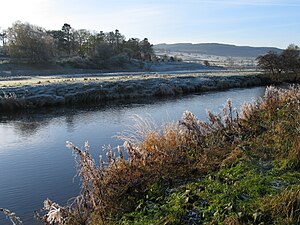River Coquet
The River Coquet runs through Northumberland, discharging into the North Sea on the coast at Amble. The river gives its name to Coquetdale around Rothbury, and the larger Coquetdale Ward. Warkworth and its castle are built in a loop of the Coquet.
The river is about 40 miles long. It rises in the Cheviot Hills and follows a course generally easterly, but greatly winding. It passes Harbottle, near which relics of the Stone Age are seen, and comes to Holystone. At Holystone it is recorded that Bishop Paulinus baptized a great body of Northumbrians in the year 627. Several earthworks crown hills above this part of the valley and at Cartington, Tosson and Whitton are relics of mediæval border fortifications.
The small town of Rothbury sits beneath the rugged Simonside Hills. The river dashes through a narrow gully called the Thrum, and then passes Brinkburn Priory, of which the fine Transitional Norman church was restored to use in 1858, while there are fragments of the monastic buildings. This was an Augustinian foundation of the time of King Henry I.
A short distance below this the Coquet has its mouth in Warkworth Harbour, with the small port of Amble on the south bank, and Coquet Island a mile out to sea.
The river is frequented by sportsmen for salmon and trout fishing. No important tributary is received, but ten smaller tributaries do join the river at intervals, including Usway Burn and the River Alwin.
Historical and literary interest
The earliest known reference to the River Coquet is found in the 7th Century Ravenna Cosmography, where it is known as Coccoveda.
Bede referred to Cocuedi fluminis.[1] This can be roughly translated to 'Red River', perhaps reflecting the red porphyritic pebbles found here in large numbers.[2]
The area provides the background to William Gibson's 1828 poem 'The Sailor or the Coquet Cottage and other Poems some in the Scottish Dialect.' Copies of this very rare book are in the British Library and also in the Duke of Northumberland's library at Alnwick Castle.
Outside links
- Location map: 55°22’5"N, 2°20’53"W
- Streetmap: NT780083
- Bridges On the Coquet
- The Roman Map of Britain - Coccuveda
